Why peonies do not bloom in the garden: what to do, how to care for the bushes to bloom magnificently
You ended up on this stuff because your peonies don't bloom, right? This is a very well-known and common problem, and there can be many reasons.
Yes, unfortunately, sometimes it happens that you have planted peonies, and they do not bloom in any way or suddenly stop blooming (including after transplantation). Why this is happening, and what needs to be done so that the peonies begin to bloom again magnificently and brightly - read about this below.
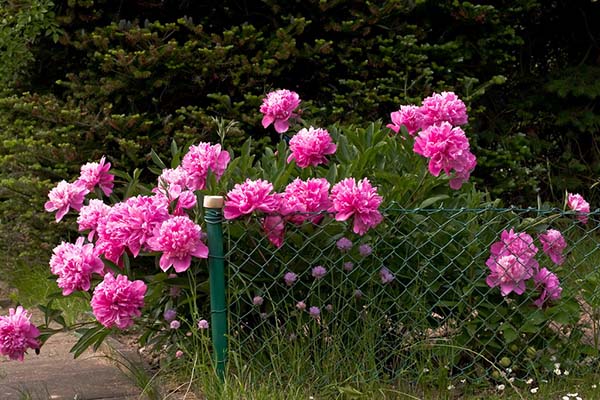
Content
Why peonies do not bloom: reasons and what to do, how to properly care for the plants to bloom magnificently
Many novice growers are often faced with the fact that peonies either do not bloom at all, or at first they pick up buds, and then they dry up and fall off. Why is this happening, and what mistakes were made when planting (or transplanting) and while caring for these beautiful perennial flowers?
Of course, in order for peonies to bloom magnificently and for a long time every year, you need to remember about the basic agricultural techniques, on the accuracy of which it depends.
Next, let's try to figure out the main reasons for the lack of flowering in peonies in the garden, as well as what can be done to solve this problem.
Note! In peonies, the stems come out immediately with buds. If there are no buds, and the leaves are large, then they will not bloom.
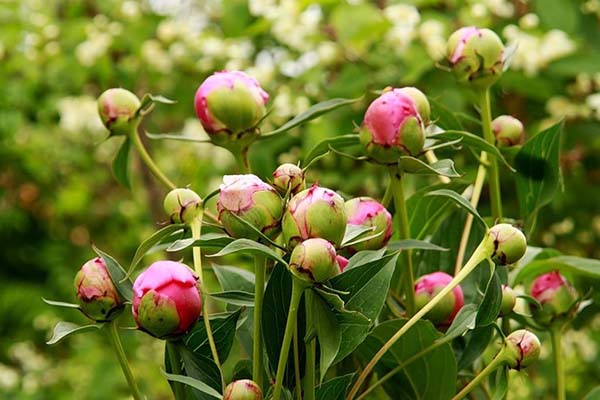
The time has not come
The main mistake of many novice flower growers is that they expect a rapid flowering of peonies literally immediately after planting the bushes in open ground.
But you need to understand that peonies,planted in a permanent place in the spring, during the season they will only take root and grow roots. By the fall, most varieties will only have flower buds that will bloom only in the next season after planting.
If the seedlings were planted in autumn, then they can bloom next year.
However! In the first year after planting, it is advisable not to let the peonies bloom (that is, to break off the buds) so that the bush gains strength as it should (build up a powerful root system).
Therefore, you should not panic if after planting your peonies do not begin to bloom - it is just that the time has not yet come for this, wait.
Moreover, you should not wait for flowering if your seedlings had too small roots, i.e. it will take time for them to grow up. Flowering occurs when the rhizomes become 10 cm or more in length.
It is also possible that the flowering period will move another 1 season or 2 if the planting or care conditions have not been met.
Thus, most often peonies begin to bloom only in the 2-3rd year, and from 3-4 years old - abundantly.
Mistakes when planting peonies
Most often, peonies do not bloom due to the fact that you initially planted them incorrectly, namely, you chose the wrong time, the wrong place, or you planted them incorrectly.

Video: why peonies do not bloom - how to plant them correctly
Bad timing
It is believed that the best time to plant peonies is late summer - early autumn (August-September). But after the spring planting in open ground, the plants get sick for a long time and slowly take root.
However, what if the garden centers bring peonies in the spring, and in the fall only half-dead, unsold specimens remain on sale?
There is nothing left but to plant in the spring according to all the rules. And most importantly, do not skimp on fertilizers, thanks to them, the peonies will be able to quickly take root in a new place, grow roots and bloom.
By the way! The site has an article about how to plant peonies in open ground in spring or transplant.
Recessed landing
One of the most popular reasons for the lack of flowering in peonies is their direct incorrect planting, namely, excessive deepening of growth points (buds).
The fact is that the planting hole is recommended to be done in advance. However, it is often dug on the day of planting and subsequently the earth begins to settle, and with it the rhizomes deepen. In such cases, the seedling can be raised higher or transplanted.
So, the points of growth (buds of renewal) should be no deeper than 4-5 cm (if the ground is light, then it is possible by 5-6 cm, if heavy, then by 3-4 cm).
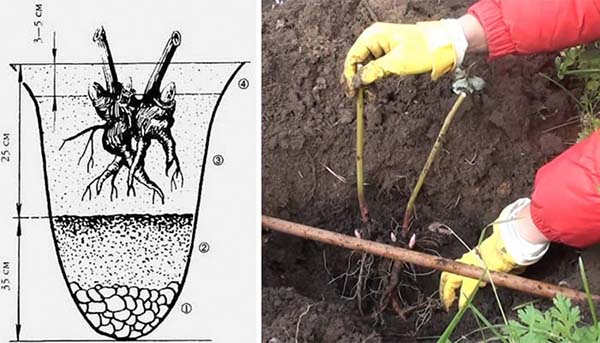
If you deepen the seedling too much, then the plant may support or simply not bloom (or weakly), although outwardly it will look completely normal at first. On the contrary, if the seedling is too close to the surface of the earth, then its buds may freeze slightly in winter and it will again bloom very inactive.
Advice! About, how to properly prepare a planting pit and plant peonies, read in this article about their autumn and spring planting.
Wrong choice of location
The reasons for the lack of flowering are too shady area, close occurrence of groundwater, acidic soil.
In order for peonies to safely take root in your garden plot, begin to actively grow and develop, and then please you with lush flowering, you must definitely choose a suitable place for their placement, which must meet the following requirements:
- Well lit (have enough sunlight), although in light partial shade, the shrub also blooms well. It is optimal if in the afternoon in the afternoon (that is, in the very heat) the peonies will be in shade, and the rest of the time - in the sun (preferably in the morning - before lunch). If you plant a shrub in a too shady place, then the stems of the peony will begin to stretch out and inflorescences become smaller. Or flowering will stop altogether.

Advice! Do not plant peonies between or under sprawling trees or overgrown shrubs that will constantly shade flower bushes. Although, if you plant on the south side (southwest or east), then this is perfectly acceptable. But not from the north!
- The plot must beprotected from drafts and strong windsand also havegood air circulationthat should not stagnate.
- In no case do not plant peonies in damp places... The plant is very prone to getting wet. Accordingly, it is not recommended to place seedlings on an area with very low groundwater levels (less than 70-80 cm from the surface). This arrangement negatively affects the roots of the peony - they begin to rot, which leads to disease and death.
Alternatively, you can plant peonies in tall beds.

Peonies will grow best on neutral acidity 6.5 pH (6-7 pH), loamy (soils with a high clay content and a significant amount of sand) or sandy loam soils. Such soil is capable of both receiving well and retaining nutrient moisture.
Important! If the soil is acidic, then you need it deacidify, adding, for example, lime, dolomite flour, wood ash (the latter are also excellent fertilizers).
It's time to transplant
If 3-5 years after planting the peony has not bloomed (or it blooms too weakly), then you have no choice but to dig it up and transplant it to a new place (if the matter is in the wrong initial planting).
The same should be done with old peonies (over 10 years old), the flowering of which has noticeably weakened, and the bushes are all overgrown (thickened) and outgrown (they have a lot of leaves and thin stems).
Advice! Actually, transplantation and division of peonies also need to be done correctly (including digging), which is what you read in this detailed material.
Mistakes when caring for peonies
Proper care of the plant after planting is an equally important element in the successful cultivation of peonies. Naturally, if you plant and forget about your flowers, then they may never bloom.
Advice! If you want to have the largest flowers possible, then, when the plant picks up buds (budding period), only one bud should be left on the stem, and the rest (lateral) should be cut off, that is, one bud on one shoot.
But if you don't care what size the flower will be, then you can leave the side buds. This will extend the flowering period of the bush (the side ones will bloom later).
Much depends on the state of the plant: if the peony is strong, powerful, then you don't need to remove the buds. A perennial will bloom profusely, luxuriantly, large and long so.
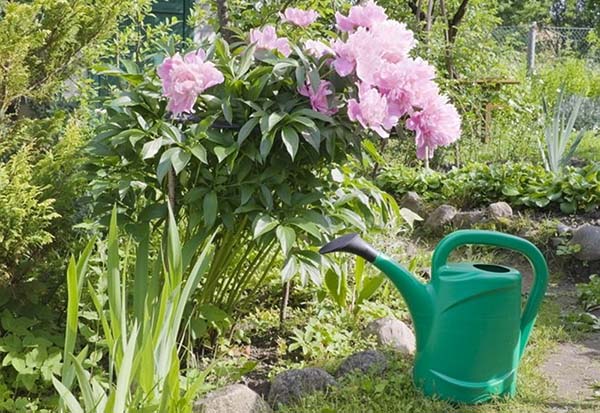
Insufficient watering or waterlogging
Weak peony bloom can be triggered by a lack of moisture in the soil. It is especially important to regularly water before flowering (including budding), as well as during the laying of new flower buds, i.e. after flowering - in the second half of summer (July-August).
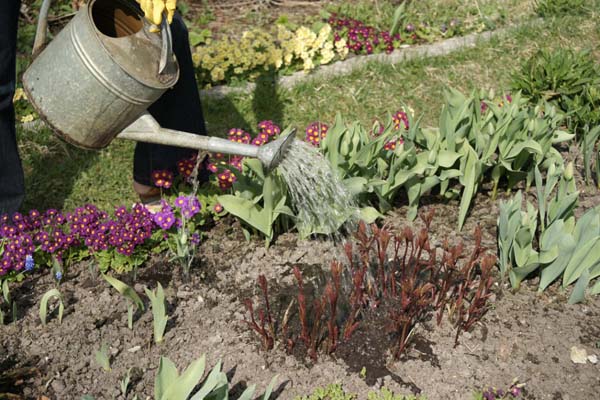
Advice! To reduce the frequency of watering, simply mulch your bushes.Mulch will protect your plants from overheating and retain moisture longer.
Wrong choice and untimely fertilization, excess or lack of fertilizing
If you initially put enough fertilizer into the planting hole before planting seedlings, then the peonies will be able to develop normally and bloom profusely for several years in a row without additional fertilizing.
In general, peonies need to be fed correctly and on time.
By the way! The site already has a detailed article about feeding peonies in spring.
However, excessive application of nitrogen fertilizers will necessarily negatively affect the flowering of perennials, because he will begin to "fatten" - to drive shoots and green mass.
By the way! If you realized that you have overfed the bushes with nitrogen, then fertilizers should be applied with an increased amount of potassium and phosphorus, but within reasonable limits.
Especially important do not apply nitrogen after flowering and in autumn, during this period, the shrubs need exclusively phosphorus-potassium fertilizers (yes, there is nitrogen in superphosphate, but in an acceptable amount).
Thus, during the season, especially in the spring, it is enough to feed the peonies 3-4 times with liquid fertilizers.
Interesting! It is believed that exactly lack of potassium causes drying and falling off of still unopened buds... Therefore, at the very first signs of potassium starvation (the buds do not increase in size), it is necessary to promptly carry out foliar (by leaves) feeding of peonies - to spray the bushes with a liquid solution of potassium fertilizer.
Autumn care and preparation for winter
The composition of the autumn measures for the care and preparation of peonies for winter, again, includes feeding, as well as pruning and sheltering plants for the winter. Correct implementation of these activities also affects the flowering of the shrub.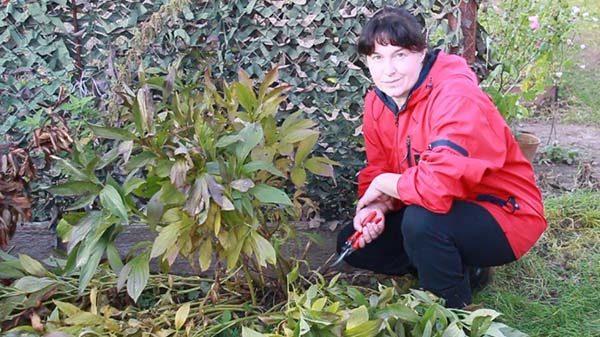
Note!In general, about what to do with peonies in autumn (how to feed, how to cut and cover) and how to properly prepare them for winter, read in this article.
Other possible reasons why peonies don't bloom
Of course, there are completely uncontrollable weather phenomena (temperature drops) that negatively affect the flowering of peonies.
So, plants may not be trite to bloom due to damage to buds by late spring frosts and / or very abundant morning growth. At the same time, this may not have any effect on some varieties, while others turn out to be more sensitive to weather disasters.
Diseases and pests of peonies
Diseases and pests are also often the reasons for the lack of flowering in peonies.
If you find that someone is eating the stalks of peonies from the inside, penetrating them at soil level, then be sure to treat the plant with a systemic insecticide such as Aktara or Kinmix.
Quite often, peonies are affected by such a dangerous fungal disease as botrytis (gray rot)... Literally at one moment, the central part of the root (the middle of the bush) can simply die off. The external symptoms of the disease are manifested in the fact that in the spring the growing stems rot at the base, lie down, and the leaves and buds are covered with a rusty bloom and then dry out.
The active development of the disease is facilitated by high humidity (cold and rainy weather in spring and summer), sharp changes in air temperature. Overly thickened and poorly ventilated plantings can also contribute further, as can excessive shading. And also an excessive amount of nitrogen fertilizers.
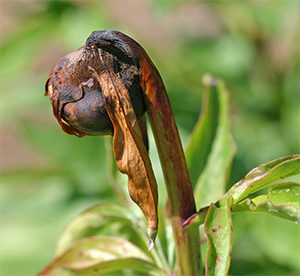
In addition, peonies are often affected by rust, various spots (cladosporium or brown spot, as well as septoria or brown spot) and root rot.

It is possible and necessary to fight gray rot and other fungal diseases of peonies with the help of preventive spraying. For example, in the spring, the bushes can be treated with Bordeaux liquid (0.5% solution), copper sulfate or foundation. It is also recommended to periodically apply to the soil wood ash and do not overdo it with nitrogen fertilizers.
If the plant is already sick, then it can be sprayed with medications, for example, Skor or Topaz.
Important! If the treatments do not help, then peonies (in case of defeat by Botrytis) needdivide and transplant: dig up, divide (leave healthy lateral processes) and be sure to remove the affected part of the roots.
Thus, now you know the main reasons why peonies may not bloom. Carefully examine the appearance of the plant, analyze your situation - make a diagnosis, and then promptly eliminate possible problems. Good luck!
Video: why peonies do not bloom


read everything. learned a lot. I will use your advice. Thank you
Thank you. Great review!